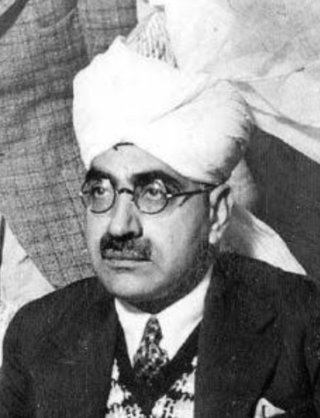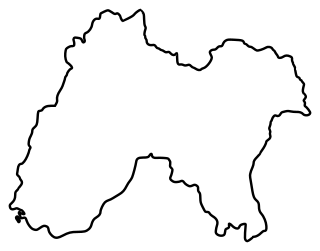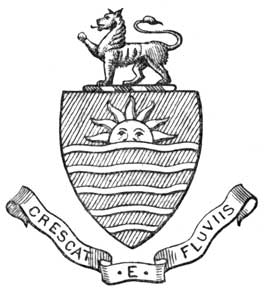Related Research Articles

The Pakistan Movement was a nationalist and political movement in the first half of the 20th century that aimed for the creation of Pakistan from the Muslim-majority areas of British India. It was connected to the perceived need for self-determination for Muslims under British rule at the time. Muhammad Ali Jinnah, a barrister and politician led this movement after the Lahore Resolution was passed by All-India Muslim League on the 23 March 1940 and Ashraf Ali Thanwi as a religious scholar supported it.

Sir Malik Khizar Hayat TiwanaKCSI, OBE was an Indian statesman, landowner, army officer, politician belonging to the Punjab Unionist Party. He served as the prime minister of the Punjab Province of British India between 1942 and 1947. He opposed the Partition of India and the ideology of Muslim League. He was eventually ousted from office by the Muslim League through a civil disobedience campaign, plunging Punjab into communal violence that led to the parition of the province between India and Pakistan.

Khan Bahadur Captain Sir Sikandar Hayat Khan,, also written Sikandar Hyat-Khan or Sikandar Hyat Khan, was an Indian politician and statesman from the Punjab who served as the Premier of the Punjab, among other positions.
The National Unionist Party was a political party based in the Punjab Province during the period of British rule in India. The Unionist Party mainly represented the interests of the landed gentry and landlords of Punjab, which included Muslims, Hindus and Sikhs. The Unionists dominated the political scene in Punjab from World War I to the independence of India and Pakistan in 1947. The party's leaders served as Prime Minister of the Punjab.

Major Shaukat Hayat Khan was an influential politician, military officer, and Pakistan Movement activist who played a major role in the organising of the Muslim League in the British-controlled Punjab.

Pakpattan, often referred to as Pākpattan Sharīf, is the capital city of the Pakpattan District, located in Punjab province of Pakistan. It is the 48th largest city of Pakistan by population according to the 2017 census. Pakpattan is the seat of Sufi Chisti order in Pakistan, and a major pilgrimage destination on account of the Shrine of Baba Farid, a renowned Punjabi poet and Sufi saint. The annual urs fair in his honour draws an estimated 2 million visitors to the town.
Raja Ghazanfar Ali Khan Khokhar was an Indian politician and monarch. He was born in Pind Dadan Khan, a town in Jhelum district, British India. He was a leading member of the All India Muslim League and a trusted lieutenant of Muhammad Ali Jinnah, serving in the Interim Government of India of 1946 as a Member of the Central Legislative Assembly of India.

Khawaja Muhammad Qamar Ud Din Sialvi (1906–1981) known as Shaykh-ul-Islam was a Pakistani Islamic scholar, religious leader and politician. He was a Waliullah of the Chishti Sufi order; his Sufi convent (zawyah) is located in the village of Sial Sharif.
Muhammad Amjad, was a legal scholar of Qur'an, Hadith, and the Hanafi school of Islamic law.
Khan Sahib, Qazi Zafar Hussain came from a qadi's family which had, since the 16th century, been prominent among the landed aristocracy of the Soon Valley. He belonged to Awans tribe of ancient repute. He was awarded the title of Khan Sahib by the British Crown. This was a formal title, a compound of khan (leader) and sahib (Lord), which was conferred in Mughal Empire and British India. Although his father, Qazi Mian Muhammad Amjad forbade his descendants to establish Dargah, he was considered Sajjada Nashin by the people of his area. "Sajjada nashins" David Gilmartin asserts, "claimed to be the descendants of the Sufi, 'saints', intermediaries between the Faithful and their God, and this cut against the grain of Islamic orthodoxy ... in kind, of their special religious status, these sajjada nashins had become men of local standing in their own right." However he never claimed to be a Sajjada Nashin. In the Punjab, the sajjada nashin or pir families were not so rich in terms of land as the great land lords of Punjab but these sajjada nashin or pir families exerted great political and religious influence over the people. The British could not administer the area without their help and no political party could win the election without their help.

When the All-India Muslim League was founded at Dacca, on 30 December 1906 at the occasion of the annual All India Muhammadan Educational Conference, It was participated by the Muslim leaders from Punjab, i.e., Sir Mian Muhammad Shafi, Mian Fazl-i-Hussain, Abdul Aziz, Khawaja Yusuf Shah and Sh. Ghulam Sadiq. Earlier Mian Muhammad Shafi organised a Muslim Association in early 1906, but when the All-India Muslim League was formed, he established its powerful branch in the Punjab of which he became the general secretary. Shah Din was elected as its first president. This branch, organised in November 1907, was known as the Punjab Provincial Muslim League.

Provincial elections were held in British India in January 1946 to elect members of the legislative councils of the Indian provinces. The consummation of British rule in India were the 1945/1946 elections. As minor political parties were eliminated, the political scene became restricted to the Indian National Congress and the Muslim League who were more antagonised than ever. The Congress, in a repeat of the 1937 elections, won 90 percent of the general non-Muslim seats while the Muslim League won the majority of Muslim seats (87%) in the provinces. Nevertheless, the All India Muslim League verified its claim to be the sole representative of Muslim India. The election laid the path to Pakistan.
Pir Syed Jamaat Ali Shah was a Pakistani Author, Islamic scholar and Sufi saint of the Naqshbandi Order. He Presided the All India Sunni Conference and leaded the Movement for Shaheed Ganj Mosque. He was a contemp of Ahmed Raza Khan Barelvi, the founder of Barelvi movement.

Nawab Iftikhar Hussain Khan of Mamdot was a Pakistani politician and an advocate of the Pakistan Movement in British India. After Pakistan's Independence, He served as the 1st Chief Minister of West Punjab and later as the Governor of Sindh.
Tiwana or Tawana is a widespread Punjabi tribe that claims both Jat and Rajput affiliation.
Malik Sahib Khan TiwanaCSI was a Punjabi Muslim Jatt landowner during the British India.

Opposition to the Partition of India was widespread in British India in the 20th century and it continues to remain a talking point in South Asian politics. Those who opposed it often adhered to the doctrine of composite nationalism in the Indian subcontinent. The Hindu, Christian, Anglo-Indian, Parsi and Sikh communities were largely opposed to the Partition of India, as were many Muslims.

Elections to the Punjab Provincial Assembly were held in January 1946 as part of the 1946 Indian provincial elections.
Abul Muhasin Muhammad Sajjad was an Indian Islamic scholar who was one of the most influential ulemas of the 20th century. Sajjad was a founder of Anjuman-Ulama-i-Bihar, Jamiat Ulema-e-Hind, and Imarat-i-Sharia. A leader in the Indian independence movement, Abul Muhasin Muhammad Sajjad participated in the Non-cooperation Movement, Khilafat Movement, and Civil Disobedience Movement; he opposed the partition of India and championed the concept of composite nationalism. He also founded the Muslim Independent Party in 1935 to represent Muslims in Bihar who were disillusioned with Congress and the Muslim League.The Muslim Independent Party formed the government in Bihar in 1937. Yunus, the party president, became the chief minister of Bihar on 1 April 1937.

The British Punjab Provincial Assembly, or simple the Punjab Provincial Assembly was the unicameral elected legislature of British Punjab, a province of the British Raj. Established by the British authorities under Government of India Act 1935, the assembly had executive powers and members directly elected from 175 constituencies by first past the post system.
References
- ↑ Sufi Saints and State Power, by Sarah F. D. Ansari, Cambridge University Press
- ↑ Rural Punjab had been converted to Islam by the proselytizing activities of Sufis, and these Sufi 'saints' were the focus of Punjab's local and fragmented structure of devotional activities.
- ↑ David Gilmartin, Religious leadership and the Pakistan movement in the Punjab, Modern Asian Studies 13, 3(1979).
- ↑ Punjab and Raj,1849–1947, by Ian Talbot, Riverdale MD: The Riverdale Company, 1989
- ↑ Gilmartin 1988 , pp. 221–222. quoted in Jinnah and Punjab: A study of the Shamsul Hasan Collection
- ↑ Wadi Soon Sakesar, The Soon Valley, by Sufi Sarwar Awan, published by Al-Faisal Nashran, Lahore, a joint venture of Lok Virsa, Islamabad and Al-Faisal Nashran, Lahore, copyright Lok Virsa, Islamabad 2003
- ↑ Wady Soon Sakesar, (The Soon Valley), by Sufi Sarwar published by Al- Faisal Nashran, Lahore, a joint venture of Lok Virsa, Islamabad and AL-Faisal Nashran, Lahore, copyright Lok Virsa, Islamabad 2002.
- ↑ Iqbal and Provincial Politics of Punjab (1927–1939), by Khurram Mahmood. http://eprints.hec.gov.pk/2449/1/2315.htm
- ↑ Communal Politics in Punjab (1926–1948) p.117, by Samina Yasmeen. "Archived copy" (PDF). Archived from the original (PDF) on 4 March 2012. Retrieved 30 May 2010.
{{cite web}}: CS1 maint: archived copy as title (link) - ↑ Zinda Rud, by Javed Iqbal
- ↑ Relations between the Muslim league and the Panjab national unionist party 1935–47
- ↑ "Raghuvendra Tanwar, Politics of Sharing Power: The Punjab Unionist Party 1924–1948, New Delhi 1999. p. 133
- ↑ Talbot, Ian (1996). Khizr Tiwana, the Punjab Unionist Party and the Partition of India. Psychology Press. pp. 82–. ISBN 978-0-7007-0427-9.